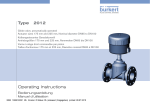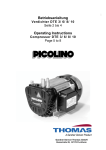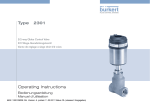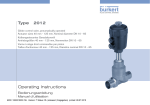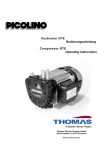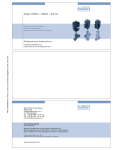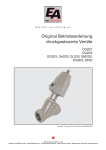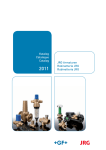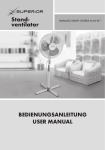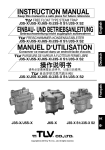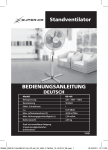Download Operating Instructions Type 2000, 2012, 2702, 2712
Transcript
Type 2000, 2012, 2702, 2712 2/2-way valve, manually actuated 2/2-Wege-Ventil handbetätigt Vanne 2/2 à commande manuelle Operating Instructions Bedienungsanleitung Manuel d‘utilisation We reserve the right to make technical changes without notice. Technische Änderungen vorbehalten. Sous réserve de modifications techniques. © 2012 - 2013 Bürkert Werke GmbH Operating Instructions 1309/02_EU-ML_00810028 / Original DE Types 2000, 2012, 2702, 2712 Table of Contents 1. operating instructions....................................................................4 1.1.Definition of the term 'Device'......................................................... 4 2. Symbols.............................................................................................................4 3. Intended use.................................................................................................5 6. Structure and Function..................................................................7 6.1.Structure............................................................................................. 7 6.2.Valve types.......................................................................................... 7 6.3.Handwheel.......................................................................................... 7 6.4.Position indicator............................................................................... 7 4. General information............................................................................5 4.1.Contact addresses........................................................................... 5 4.2.Warranty.............................................................................................. 5 4.3.Information on the Internet.............................................................. 5 7. Assembly...........................................................................................................8 7.1.Preparatory work............................................................................... 8 7.2.Installation........................................................................................... 9 5. Technical data............................................................................................6 5.1.Conformity.......................................................................................... 6 5.2.Standards............................................................................................ 6 5.3.General technical data..................................................................... 6 5.4.Type label............................................................................................ 6 9. Disassembly................................................................................................ 10 8. Start-up.............................................................................................................9 10. Maintenance work............................................................................. 10 11. Transportation, Storage, Disposal................................. 10 english 3 Types 2000, 2012, 2702, 2712 Operating instructions 1. Operating instructions The operating instructions describe the entire life cycle of the device. Keep these instructions in a location which is easily accessible to every user and make these instructions available to every new owner of the device. The operating instructions contain important safety information! Failure to observe these instructions may result in hazardous situations. • The operating instructions must be read and understood. Information on spare parts can be found in the instructions for angle seat valve type 2000, 2702 or straight seat valve type 2012 and 2712 at: www.burkert.com If you have any queries, please contact your Bürkert sales office. 1.1. Definition of the term 'Device' The term "device" used in these instructions always stand for the manually actuated angle seat valve types 2000, 2702 or the manually actuated globe valve types 2012 and 2712. 4 english 2. Symbols Warning to prevent death or serious injuries: Danger! Warns of an immediate danger! Warning! Warns of a potentially dangerous situation! Warning to prevent moderate or minor injuries: Caution! Warns of a possible danger! Note! Warns of damage to property! Important tips and recommendations. Refers to information in these operating instructions or in other documentation. →→Designates a procedure which you must carry out. Types 2000, 2012, 2702, 2712 Intended use 3. Intended use The manually actuated valve types 2000, 2012, 2702 and 2712 are designed to control the flow rate of liquid media. • Observe the permitted application conditions for using the equipment. • Operate only when in perfect condition and pay attention to correct storage, transportation, installation and operation. Danger – high pressure! • Turn off the pressure and vent the lines before loosening lines or valves. 4. General information 4.1. Contact addresses Germany Bürkert Fluid Control Systems Sales Center Christian-Bürkert-Str. 13-17 D-74653 Ingelfingen Germany Tel. + 49 (0) 7940 - 10 91 111 Fax + 49 (0) 7940 - 10 91 448 Email: [email protected] To prevent injuries/damage: • Secure system/equipment from unintentional activation. International • Only supply fluids into the media connections that are specified in section “5. Technical data”. • Do not make any internal or external changes. • Only trained technicians may perform installation and maintenance work. • Do not apply a mechanical load to the body. • Observe the general regulations of technology. www.burkert.com Contact addresses can be found on the Internet at: 4.2. Warranty The warranty is only valid if the manually actuated valve is used as intended in accordance with the specified application conditions. 4.3. Information on the Internet The operating instructions and data sheets for types 2000, 2012, 2702 and 2712 can be found on the Internet at: www.burkert.com english 5 Types 2000, 2012, 2702, 2712 Technical data 5. Technical data Temperatures 5.1. Conformity Media The manually actuated valve types 2000, 2012, 2702 and 2712 complies with the EC Directives according to the EC Declaration of Conformity. 10 to +180 °C (max. +130 °C recom– mended for seat seal PTFE/steel) Environment –10 to +60 °C Materials and connections 5.2. Standards The applied standards on the basis of which compliance with the EC Directives is confirmed are listed in the EC type examination certificate and/or the EC Declaration of Conformity. 5.3. General technical data See data sheet Installation position: d efined by the user (preferably with actuator facing up) Orifices Media Flow media: eutral gases, water, alcohols, oils, N fuels, saline solutions, lyes, organic solvents, steam Direction of flow: ypes 2000, 2012 defined by the user T Types 2702, 2712 below the seat Viscosity: max. 600 mm2/s Media pressure: 6 DN 4–25: PN 16 (or see type label) DN 32–50: PN 10 (or see type label) english 5.4. Type label Orifice Control function Type Connection type Made in Germany Types 2000, 2702, 2012 DN 15–50 Type 2712 DN 4–50 Flow 1 2 2000 0 25,0 PTFE VA G1 Pmed 16bar 00219722 Direction of flow Sealing material Body material Nominal pressure W37MA Identification number Fig. 1: Example of type label An dieser Zeichnung beanspruchen wir Eigentumsund Urheberrecht. Nur mit unserer Zustimmung darf sie vervielfältigt, anderen mitgeteilt oder anderweitig verwendet werden. Types 2000, 2012, 2702, 2712 Structure and Function 6. Structure and Function Handwheel with position indicator (optional) 6.1. Structure 6.2. Valve types Type Body Angle seat body 2702 2012 Globe valve body 2712 1) Opening for lock Properties - Manual actuator - Without control cone - For shut-off function only 2000 An dieser Zeichnung beanspruchen wir Eigentumsund Urheberrecht. Nur mit unserer Zustimmung darf sie vervielfältigt, anderen mitgeteilt oder anderweitig verwendet werden. An dieser Zeichnung beanspruchen wir Eigentumsund Urheberrecht. Nur mit unserer Zustimmung darf sie vervielfältigt, anderen mitgeteilt oder anderweitig verwendet werden. The valve consists of a manual actuator and a 2/2-way valve body. By manually actuating the handwheel, the force is transferred via a spindle and the valve is opened or closed. - Manual actuator - With control cone - With position indicator for setting a defined flow1) Angle seat body Fig. 2: Position indicator in mm = valve opening in mm Straight seat body Version Revision Änderungsnr. Bürkert Datum Änderungstext Werkstoff Fluid Control Systems D-74653 Ingelfingen Valve types Maße ohne Toleranzangabe Name Ersteller 6.3. Handwheel Längenmaße Bearbeiter Rundungshalbmesser Status Winkelmaße Zeichn.Nr. Klass-Nr. Projekt-Nr. Maßstab: Ers.f. Datum 18.07.12 DKI Benennung 2/2-Wege-Geradsitz-Regelventil In Arbeit Typ 2712 Unterlagenart Materialnummer Dok.art Dokument-Id. 9000228215 Var.stl.: SK00 00207149 XXX Sprache DE Masse: Blatt von SW 1 1 0.00 g Each revolution of the handwheel changes the valve position by 1.5 mm (see “Fig. 3”). Clockwise rotation closes the valve, counterclockwise rotation opens it. Version Revision Änderungsnr. Bürkert Datum Änderungstext Werkstoff Version Revision Änderungsnr. Fluid Control Systems D-74653 Ingelfingen Maße ohne Toleranzangabe Name Ersteller Längenmaße Bearbeiter Rundungshalbmesser Status Winkelmaße Zeichn.Nr. Klass-Nr. Projekt-Nr. Maßstab: Ers.f. Datum 18.07.12 DKI Maße ohne Toleranzangabe Längenmaße 2000 Unterlagenart Materialnummer Dokument-Id. 9000228212 SK00 00219723 Bearbeiter Rundungshalbmesser Sprache Blatt Dok.art Winkelmaße von Klass-Nr. XXX Var.stl.: Maßstab: DE Masse: Name Ersteller 2/2-Wege-Handschrägsitzventil In Arbeit Typ Bürkert Datum Änderungstext Werkstoff Fluid Control Systems D-74653 Ingelfingen Benennung SW 1 1 Status Datum 18.07.12 DKI Benennung 2/2-Wege-Geradsitz-Regelventil In Arbeit Zeichn.Nr. Projekt-Nr. Typ 2712 0.00 g Ers.f. Unterlagenart Materialnummer Dok.art Dokument-Id. 9000228215 Var.stl.: SK00 00207149 XXX Sprache DE Masse: Blatt von SW 1 1 0.00 g - Manual actuator - Without control cone - For shut-off function only Only a low torque of 5–10 Nm is required to seal the valve. - Manual actuator - With control cone - With position indicator for setting a defined flow1) The value of the display is a distance in mm, usually the current valve stroke (valve opening in mm). The display after the vertical line shows the steps in 1/10 mm. ossible with and without interlock to prevent intentional and P unintentional adjustment of the set valve position 6.4. Position indicator To set a defined flow, please refer to the flow characteristics or the Kv value table (see data sheet). If valves feature an interlock, the set position can be secured with a lock. english 7 Types 2000, 2012, 2702, 2712 Assembly 7. + 1.5 mm valve opening Assembly Danger! Valve opening in 1/100 mm Valve opening in 1/10 mm Valve opening in mm Fig. 3: Position indicator handwheel 6.4.1. Setting the position indicator The display has been set at the factory so that the value 0,000 is shown when the valve is tightly closed. Any valve position can be defined as the zero position: →→Move valve to the required position by turning the handwheel. →→Loosen the 3 setscrews on the circumference of the locking ring. →→Set display by simultaneously holding the handwheel and turning the locking ring to the value 0,000. →→Clamp locking ring with the 3 setscrews. 8 english Risk of injury from high pressure in the system. • Before loosening lines or valves, turn off the pressure and vent the lines. 7.1. Preparatory work →→Observe flow direction (see type label). →→Clean pipelines (sealing material, swarf, etc.). Devices with welded body: Remove the actuator from the valve body: →→Open valve by approx. 2 revolutions (to relieve the valve seat seal) →→Place a suitable open-end wrench on the wrench flat of the nipple. →→Unscrew the actuator off the valve body. Devices with socket body: →→Only disassemble the actuator if required by the customer. Types 2000, 2012, 2702, 2712 Assembly 7.2. Installation Warning! Risk of injury from improper installation! Damaged parts or incorrect tightening torques can cause leaks on the equipment. • Use an open-end wrench for the assembly. • Observe the tightening torque (see torque table). 7.2.1. Installing the body Orifice (DN) 15 20 25 32-40 50-65 Tightening torque ± 3 [Nm] 45 50 60 65 70 Tab. 1: 8. Torque for screwing into the valve body Start-up For commissioning observe type label specifications and information on media, media pressure and temperature values in chapter “5. Technical data”. Any installation position, preferably with handwheel face up. Welded body: →→Weld valve body in pipeline system. Other body designs: →→Connect valve body to pipeline. 7.2.2. Installing the actuator (Welded Body) →→Check graphite seal and, if required, replace. Ensure that sealant residue cannot get into the pipeline system. Graphite seal →→Lubricate the nipple thread before reinstalling the actuator (e.g. with Klüberpaste UH1 96-402 produced by Klüber). →→Observe the torques when screwing the actuator into the valve body (see “Tab. 1”). english 9 Types 2000, 2012, 2702, 2712 Disassembly 9. Disassembly Danger! Risk of injury from high pressure and toxic media in the equipment. • Before loosening lines or valves, turn off the pressure and vent the lines. • If using toxic media, rinse lines. 10. Maintenance work →→Complete a visual inspection of the equipment once a year. Shorter maintenance intervals may be recommended depending on the operating conditions. →→In the event of a leak, replace the relevant wear part. In this case please contact your sales office. 10 english 11. Transportation, Storage, Disposal Note! Transport and storage damage! • Protect the device against moisture and dirt in shock-resistant packaging during transportation and storage. • Permitted storage temperature: -20 – +65 °C. Damage to the environment caused by device components contaminated with media. • Dispose of the device and packaging in an environmentally friendly manner! Typ 2000, 2012, 2702, 2712 Inhaltsverzeichnis 1. Die Bedienungsanleitung............................................................. 12 1.1.Begriffsdefinition Gerät..................................................................12 2. Darstellungsmittel........................................................................... 12 3. BestimmungsgemäSSer Gebrauch1�������������������������������������� 13 4. Allgemeine Hinweise........................................................................... 13 4.1.Kontaktadressen..............................................................................13 4.2.Gewährleistung...............................................................................13 4.3.Informationen im Internet...............................................................13 5. Technische Daten................................................................................. 14 5.1.Konformität........................................................................................14 5.2.Normen..............................................................................................14 5.3.Allgemeine Technische Daten......................................................14 5.4.Typschild...........................................................................................14 6.1.Aufbau................................................................................................15 6.2.Ventiltypen........................................................................................15 6.3.Handrad.............................................................................................15 6.4.Stellungsanzeige.............................................................................15 7. Montage......................................................................................................... 16 7.1.Vorbereitende Arbeiten..................................................................16 7.2.Einbau................................................................................................17 8. Inbetriebnahme....................................................................................... 17 9. Demontage................................................................................................... 18 10. Wartungsarbeiten............................................................................ 18 11. transport, Lagerung, Entsorgung.................................. 18 6. Aufbau und Funktion........................................................................ 15 deutsch 11 Typ 2000, 2012, 2702, 2712 Die Bedienungsanleitung 1. Die Bedienungsanleitung Die Bedienungsanleitung beschreibt den gesamten Lebenszyklus des Geräts. Bewahren Sie diese Anleitung so auf, dass sie für jeden Benutzer gut zugänglich ist und jedem neuen Eigentümer des Geräts wieder zur Verfügung steht. Die Bedienungsanleitung enthält wichtige Informationen zur Sicherheit! Das Nichtbeachten dieser Hinweise kann zu gefährlichen Situationen führen. • Die Bedienungsanleitung muss gelesen und verstanden werden. Informationen zu Ersatzteilen finden Sie in der Anleitung zu Schrägsitzventil Typ 2000, 2702 bzw. Geradsitzventil Typ 2012 und 2712 unter: www.buerkert.de Darstellungsmittel Warnung vor tödlichen oder schweren Verletzungen: Gefahr! Warnt vor einer unmittelbaren Gefahr! Warnung! Warnt vor einer möglicherweise gefährlichen Situation! Warnung vor mittelschweren oder leichten Verletzungen: Vorsicht! Warnt vor einer möglichen Gefährdung! Hinweis! Bei Fragen kontaktieren Sie bitte Ihre Bürkert-Vertriebsniederlassung. Warnt vor Sachschäden! Wichtige Tipps und Empfehlungen. 1.1. Begriffsdefinition Gerät Der in dieser Anleitung verwendeten Begriff „Gerät“ steht immer für das handbetätigte Schrägsitzventil Typ 2000, 2702 bzw. das handbetätigte Geradsitzventil Typ 2012 und 2712. 12 2. deutsch Verweist auf Informationen in dieser Bedienungsanleitung oder in anderen Dokumentationen. →→markiert einen Arbeitsschritt, den Sie ausführen müssen. Typ 2000, 2012, 2702, 2712 Bestimmungsgemäßer Gebrauch 3. BestimmungsgemäSSer Gebrauch Das handbetätigte Ventil Typ 2000, 2012, 2702 und 2712 ist für die Steuerung des Durchflusses von flüssigen Medien konzipiert. • Für den Einsatz die zulässigen Einsatzbedingungen beachten. • Nur in einwandfreiem Zustand betreiben und auf sachgerechte Lagerung, Transport, Installation und Bedienung achten. 4. Allgemeine Hinweise 4.1. Kontaktadressen Deutschland Bürkert Fluid Control Systems Sales Center Christian-Bürkert-Str. 13-17 D-74653 Ingelfingen Tel. + 49 (0) 7940 - 10 91 111 Fax + 49 (0) 7940 - 10 91 448 E-mail: [email protected] Gefahr durch hohen Druck! • Vor dem Lösen von Leitungen oder Ventilen den Druck abschalten und Leitungen entlüften. International Zum Schutz vor Verletzungen/Sachschäden beachten: • Anlage/Gerät vor unbeabsichtigtem Betätigen sichern. www.burkert.com • In Medienanschlüsse nur Medien einspeisen, die im Kapitel „5. Technische Daten“ aufgeführt sind. • Keine inneren oder äußeren Veränderungen vornehmen. • Nur geschultes Fachpersonal darf Installations- und Instandhaltungsarbeiten ausführen. • Gehäuse nicht mechanisch belasten. • Die allgemeinen Regeln der Technik einhalten. Die Kontaktadressen finden Sie im Internet unter: 4.2. Gewährleistung Voraussetzung für die Gewährleistung ist der bestimmungsgemäße Gebrauch des handbetätigten Ventils unter Beachtung der spezifizierten Einsatzbedingungen. 4.3. Informationen im Internet Bedienungsanleitungen und Datenblätter zum Typ 2000, 2012, 2702 und 2712 finden Sie im Internet unter: www.buerkert.de deutsch 13 Typ 2000, 2012, 2702, 2712 Technische Daten 5. Technische Daten Temperaturen 5.1. Konformität Medien Das handbetätigte Ventil Typ 2000, 2012, 2702 und 2712 ist konform zu den EG-Richtlinien entsprechend der EG-Konformitätserklärung. 10 bis +180 °C (max. +130 °C empfohlen – für Sitzabdichtung PTFE/Stahl) Umgebung –10 bis +60 °C 5.2. Normen Werkstoffe und Anschlüsse Die angewandten Normen, mit denen die Konformität mit den EG-Richtlinien nachgewiesen wird, sind in der EG-Baumusterprüfbescheinigung und/oder der EG-Konformitätserklärung nachzulesen. 5.3. Allgemeine Technische Daten siehe Datenblatt Einbaulage: beliebig (vorzugsweise Antrieb nach oben) Nennweiten 5.4. Typschild DN 15–50 DN 4–50 Medien eutrale Gase, Wasser, Alkohole, Öle, Durchflussmedien: N Treibstoffe, Salzlösungen, Laugen, organische Lösemittel, Dampf Nennweite Steuerfunktion Typ Anschlussart Durchflussrichtung:Typ 2000, 2012 beliebig Typ 2702, 2712 unter Sitz Viskosität: Mediendruck: 14 Made in Germany Typ 2000, 2702, 2012 Typ 2712 Flow 1 2 2000 0 25,0 PTFE VA G1 Pmed 16bar 00219722 Durchflussrichtung Dichtungswerkstoff Gehäusewerkstoff Nenndruck W37MA Identnummer max. 600 mm2/s DN 4–25: PN 16 (bzw. siehe Typschild) DN 32–50: PN 10 (bzw. siehe Typschild) deutsch Bild 1: Beispiel Typschild An dieser Zeichnung beanspruchen wir Eigentumsund Urheberrecht. Nur mit unserer Zustimmung darf sie vervielfältigt, anderen mitgeteilt oder anderweitig verwendet werden. Typ 2000, 2012, 2702, 2712 Aufbau und Funktion 6. Aufbau und Funktion Handrad mit Stellungsanzeige (optional) 6.1. Aufbau 6.2. Ventiltypen Typ Gehäuse - Handantrieb - ohne Regelkegel - zur reinen Absperrfunktion 2000 Schrägsitzgehäuse 2702 Geradsitzgehäuse 1) - Handantrieb - mit Regelkegel - mit Stellungsanzeige zur Einstellung eines definierten Durchflusses1) - Handantrieb - ohne Regelkegel - zur reinen Absperrfunktion 2012 2712 Eigenschaften Handantrieb - mit Regelkegel - mit Stellungsanzeige zur Einstellung eines definierten Durchflusses1) it und ohne Verriegelung gegen beabsichtigtes und unbeabsichtigtes M Verstellen der eingestellten Ventilstellung möglich An dieser Zeichnung beanspruchen wir Eigentumsund Urheberrecht. Nur mit unserer Zustimmung darf sie vervielfältigt, anderen mitgeteilt oder anderweitig verwendet werden. An dieser Zeichnung beanspruchen wir Eigentumsund Urheberrecht. Nur mit unserer Zustimmung darf sie vervielfältigt, anderen mitgeteilt oder anderweitig verwendet werden. Das Ventil besteht aus einem Handantrieb und einem 2/2-Wege Ventilgehäuse. Durch die manuelle Betätigung des Handrads wird die Kraft über eine Spindel übertragen und das Ventil geöffnet oder geschlossen. Öffnung für Schloss Schrägsitzgehäuse Bild 2: Stellungsanzeige in mm = Ventilöffnung in mm Geradsitzgehäuse Version Revision Änderungsnr. Bürkert Datum Änderungstext Werkstoff Fluid Control Systems D-74653 Ingelfingen Ventiltypen Maße ohne Toleranzangabe Name Ersteller 6.3. Handrad Längenmaße Bearbeiter Rundungshalbmesser Status Winkelmaße Zeichn.Nr. Klass-Nr. Projekt-Nr. Maßstab: Ers.f. Datum 18.07.12 DKI Benennung 2/2-Wege-Geradsitz-Regelventil In Arbeit Typ 2712 Unterlagenart Materialnummer Dok.art Dokument-Id. 9000228215 Var.stl.: SK00 00207149 XXX Sprache DE Masse: Blatt von SW 1 1 0.00 g Je Umdrehung des Handrads ändert sich die Ventilstellung um 1,5 mm (siehe Bild 3). Die Drehung im Uhrzeigersinn schließt das Ventil, die Drehung in Gegenrichtung öffnet es. Version Revision Änderungsnr. Bürkert Datum Änderungstext Werkstoff Version Revision Änderungsnr. Fluid Control Systems D-74653 Ingelfingen Maße ohne Toleranzangabe Name Ersteller Längenmaße Bearbeiter Rundungshalbmesser Status Winkelmaße Zeichn.Nr. Klass-Nr. Projekt-Nr. Maßstab: Ers.f. Datum 18.07.12 DKI Maße ohne Toleranzangabe Längenmaße 2000 Unterlagenart Materialnummer Dokument-Id. 9000228212 SK00 00219723 Bearbeiter Rundungshalbmesser Sprache Blatt Dok.art Winkelmaße von Klass-Nr. XXX Var.stl.: Maßstab: DE Masse: Name Ersteller 2/2-Wege-Handschrägsitzventil In Arbeit Typ Bürkert Datum Änderungstext Werkstoff Fluid Control Systems D-74653 Ingelfingen Benennung SW 1 1 Status Datum 18.07.12 DKI Benennung 2/2-Wege-Geradsitz-Regelventil In Arbeit Zeichn.Nr. Projekt-Nr. Typ 2712 0.00 g Ers.f. Unterlagenart Materialnummer Dok.art Dokument-Id. 9000228215 Var.stl.: SK00 00207149 XXX Sprache DE Masse: Blatt von SW 1 1 0.00 g Zum Abdichten des Ventils ist nur ein geringes Drehmoment von 5–10 Nm erforderlich. 6.4. Stellungsanzeige Der Wert der Anzeige ist ein Weg in mm, in der Regel der aktuelle Ventilhub (Ventilöffnung in mm). Die Anzeige nach der vertikalen Linie zeigt die Schritte in 1/10 mm. Um einen definierten Durchfluss einzustellen, nehmen Sie bitte die Durchflusskennlinie bzw. die Kv-Wertetabelle zur Hilfe (siehe Datenblatt). Bei Ventilen mit Verriegelung kann die eingestellte Position durch ein Schloss gesichert werden. deutsch 15 Typ 2000, 2012, 2702, 2712 Montage 7. + 1,5 mm Ventilöffnung Montage Gefahr! Ventilöffnung in 1/100 mm Ventilöffnung in 1/10 mm Ventilöffnung in mm Bild 3: Verletzungsgefahr durch hohen Druck in der Anlage. • Vor dem Lösen von Leitungen oder Ventilen Druck abschalten und Leitungen entleeren. 7.1. Vorbereitende Arbeiten →→Durchflussrichtung beachten (siehe Typschild). →→Rohrleitungen von Verunreinigungen säubern (Dichtungsmaterial, Metallspäne etc.). Stellungsanzeige Handrad 6.4.1. Einstellen der Stellungsanzeige Geräte mit Schweißgehäuse: Antrieb vom Ventilgehäuse demontieren: Werksseitig ist die Anzeige so eingestellt, dass der Wert 0,000 bei dicht geschlossenem Ventil zu sehen ist. →→Ventil etwa 2 Umdrehungen öffnen (zur Entlastung der Es kann jede beliebige Ventilstellung als Nullstellung definiert werden: →→An der Schlüsselfläche des Nippels mit passendem Gabelschlüssel →→Ventil durch Drehen am Handrad in gewünschte Stellung bringen. →→Die 3 Gewindestifte am Umfang des Feststellrings lösen. →→Anzeige durch gleichzeitiges Festhalten des Handrads und Drehen am Feststellring zum Wert 0,000 einstellen. →→Feststellring mit 3 Gewindestiften festklemmen. 16 deutsch Ventilsitzdichtung). ansetzen. →→Antrieb vom Ventilgehäuse abschrauben. Geräte mit Muffengehäuse: →→Antrieb nur bei kundenspezifischem Erfordernis demontieren. Typ 2000, 2012, 2702, 2712 Montage →→Antrieb in das Ventilgehäuse einschrauben, dabei Anziehdreh- 7.2. Einbau moment beachten (siehe Tab. 1). Warnung! Verletzungsgefahr bei unsachgemäßem Einbau! Beschädigte Teile oder falsches Anziehdrehmoment können Undichtheiten am Gerät verursachen. • Zur Montage einen Gabelschlüssel verwenden. • Anziehdrehmoment beachten (siehe Tabelle Anziehdrehmoment). 7.2.1. Gehäuse montieren Einbaulage beliebig, vorzugsweise Handrad nach oben. Schweißgehäuse: →→Ventilgehäuse in Rohrleitungssystem einschweißen. Nennweite (DN) 15 20 25 32-40 50-65 Anziehdrehmoment ± 3 [Nm] 45 50 60 65 70 Tab. 1: 8. Anziehdrehmoment zum Einschrauben in das Ventilgehäuse Inbetriebnahme Zur Inbetriebnahme Typschildangaben und Hinweise zu Medien, Mediendruckwerten und Medientemperaturwerten in Kapitel „5. Technische Daten“ beachten. Andere Gehäuseausführungen: →→Gehäuse mit Rohrleitung verbinden. 7.2.2. Antrieb montieren (Schweißgehäuse) →→Graphitdichtung prüfen und bei Bedarf erneuern. Darauf achten, dass keine Reste von Dichtmittel in das Rohrleitungssystem gelangen. Graphitdichtung →→Nippelgewinde vor Wiedereinbau des Antriebs einfetten (z. B. mit Klüberpaste UH1 96-402 der Firma Klüber). deutsch 17 Typ 2000, 2012, 2702, 2712 Demontage 9. Demontage 11. Transport Lagerung, Entsorgung Gefahr! Verletzungsgefahr durch hohen Druck und giftige Medien in der Anlage. • Vor dem Lösen von Leitungen oder Ventilen Druck abschalten und Leitungen entleeren. • Bei Verwendung giftiger Medien Leitungen spülen. Hinweis! Transportschäden und Lagerschäden! • Gerät vor Nässe und Schmutz geschützt in einer stoßfesten Verpackung transportieren und lagern. • Zulässige Lagertemperatur: -20 … +65 °C. Umweltschäden durch von Medien kontaminierte Geräteteile. • Gerät und Verpackung umweltgerecht entsorgen! 10. Wartungsarbeiten →→Sichtkontrolle einmal pro Jahr am Gerät durchführen. Je nach Einsatzbedingungen werden kürzere Wartungsintervalle empfohlen. →→Bei Undichtheiten das jeweilige Verschleißteil austauschen. Wenden Sie sich in diesem Fall an die zuständige Vertriebsniederlassung. 18 deutsch Types 2000, 2012, 2702, 2712 Table des matières 1. Les instructions de service...................................................... 20 1.1.Définition du terme appareil..........................................................20 2. Symboles....................................................................................................... 20 3. Utilisation conforme....................................................................... 21 6. Structure et mode de fonctionnement......................... 23 6.1.Structure...........................................................................................23 6.2.Types de vanne................................................................................23 6.3.Sélecteur...........................................................................................23 6.4.Indicateur de position.....................................................................23 4. Indications générales..................................................................... 21 4.1.Adresses...........................................................................................21 4.2.Garantie légale.................................................................................21 4.3.Informations sur Internet................................................................21 7. Montage......................................................................................................... 24 7.1.Travaux préparatoires.....................................................................24 7.2.Montage............................................................................................25 5. Caractéristiques techniques................................................. 22 5.1.Conformité........................................................................................22 5.2.Normes..............................................................................................22 5.3.Caractéristiques techniques générales.....................................22 5.4.Plaque signalétique........................................................................22 9. Démontage................................................................................................... 26 français 8. Mise en service........................................................................................ 25 10. Travaux d'entretien......................................................................... 26 11. Transport, stockage, élimination...................................... 26 19 Types 2000, 2012, 2702, 2712 Les instructions de service 1. Les instructions de service Les instructions de service décrivent le cycle de vie complet de l’appareil. Conservez ces instructions de sorte qu’elles soient accessibles à tout utilisateur et à disposition de tout nouveau propriétaire. Les instructions de service contiennent des informations importantes sur la sécurité ! Le non-respect de ces consignes peut entraîner des situations dangereuses. • Les instructions de service doivent être lues et comprises. Vous trouverez des informations concernant les pièces de rechange dans la notice relative à la vanne à siège incliné types 2000, 2702 et la vanne à siège droit types 2012 et 2712 sous : www.burkert.fr Si vous avez des questions, veuillez contacter votre filiale de distribution Bürkert. 2. Symboles Mise en garde contre des blessures graves ou mortelles : Danger ! Met en garde contre un danger imminent ! Avertissement ! Met en garde contre une situation éventuellement dangereuse ! Mise en garde contre des blessures moyennes ou légères : Prudence ! Met en garde contre un risque potentiel ! Remarque ! Met en garde contre des dommages matériels ! 1.1. Définition du terme appareil Le terme « appareil » utilisé dans ces instructions désigne toujours la vanne à siège incliné à commande manuelle, types 2000, 2702 ou la vanne à siège droit à commande manuelle, types 2012 et 2712. Conseils et recommandations importants. Renvoie à des informations dans ces instructions de service ou dans d’autres documentations. →→identifie une opération que vous devez effectuer. 20 français Types 2000, 2012, 2702, 2712 Utilisation conforme 3. Utilisation conforme 4. La vanne à commande manuelle, types 2000, 2012, 2702 et 2712, a été conçue pour commander le débit de fluides liquides. • Pour son utilisation, il convient de respecter les conditions d'exploitation et d'utilisation autorisées. • Utiliser uniquement en parfait état et veiller au stockage, au transport, à l'installation et à l'utilisation conformes. Danger dû à la haute pression ! • Avant de desserrer les conduites et les vannes, couper la pression et purger l'air des conduites. Pour prévenir les blessures/dommages matériels, veuillez tenir compte de ce qui suit : • Empêcher tout actionnement involontaire de l'installation/de l'appareil. • Alimenter les raccords de fluides seulement avec les liquides énumérés au chapitre « 5. Caractéristiques techniques ». • Ne pas effectuer de modifications internes ou externes. • Seul du personnel qualifié peut effectuer l'installation et la maintenance. • Ne pas exposer le corps à des charges mécaniques. • Respecter les règles générales de la technique. Indications générales 4.1. Adresses Allemagne Bürkert Fluid Control Systems Sales Center Christian-Bürkert-Str. 13-17 D-74653 Ingelfingen Tél. + 49 (0) 7940 - 10 91 111 Fax + 49 (0) 7940 - 10 91 448 E-mail: [email protected] International Les adresses se trouvent sur Internet sous : www.buerkert.com 4.2. Garantie légale La condition pour bénéficier de la garantie légale est l’utilisation conforme de la vanne à commande manuelle dans le respect des conditions d’utilisation spécifiées. 4.3. Informations sur Internet Vous trouverez les instructions de service et les fiches techniques concernant les types 2000, 2012, 2702 et 2712 sur Internet sous : www.buerkert.fr français 21 Types 2000, 2012, 2702, 2712 Caractéristiques techniques 5. Caractéristiques techniques Températures 5.1. Conformité Fluides 10 à +180 °C (max. +130 °C recom– mandée pour joint de siège en PTFE/acier) La vanne à commande manuelle, types 2000, 2012, 2702 et 2712, est conforme aux directives CE conformément à la déclaration de conformité CE. Température ambiante –10 à +60 °C Matériaux et raccordements 5.2. Normes Les normes utilisées, avec lesquelles la conformité avec les directives CE sont prouvées, figurent dans l'attestation CE de type et/ou la déclaration de conformité CE. voir fiche technique a u choix (de préférence actionneur vers le haut) Position de montage : 5.3. Caractéristiques techniques générales 5.4. Plaque signalétique Types 2000, 2702, 2012 DN 15–50 Type 2712 DN 4–50 Fluides Fluides transportés : az neutres, eau, alcools, huiles, g carburants, solutions salines, lessives, solvants organiques, vapeur Sens de débit : types 2000, 2012 au choix types 2702, 2712 sous le siège Viscosité : max. 600 mm2/s Diamètre nominal Fonction Type Type de raccordement Flow 1 2 2000 0 25,0 PTFE VA G1 Pmed 16bar 00219722 Sens de débit Matériau d‘étanchéité Matériau du corps Pression nominale W37MA Numéro d‘identification Fig. 1 : Exemple de plaque signalétique Pression du fluide : DN 4–25 : PN 16 (ou voir plaque signalétique) DN 32–50 : PN 10 (ou voir plaque signalétique) 22 Made in Germany Diamètres nominaux français An dieser Zeichnung beanspruchen wir Eigentumsund Urheberrecht. Nur mit unserer Zustimmung darf sie vervielfältigt, anderen mitgeteilt oder anderweitig verwendet werden. Types 2000, 2012, 2702, 2712 Structure et mode de fonctionnement 6. Structure et mode de fonctionnement Sélecteur avec indicateur de position (en option) 6.1. Structure 6.2. Types de vanne Type Corps 2000 Corps de siège incliné Version Revision Propriétés - actionneur manuel - sans cône de régulation - pour une fonction d'arrêt pure 2702 2012 - actionneur manuel - sans cône de régulation - pour une fonction d'arrêt pure 2712 1) Ouverture pour cadenas Indicateur de position en mm Corps de siège incliné Corps de siège droit = ouverture de vanne en mm - actionneur manuel - avec cône de régulation - avec indicateur de position pour le réglage d'un débit défini1) Corps de siège droit An dieser Zeichnung beanspruchen wir Eigentumsund Urheberrecht. Nur mit unserer Zustimmung darf sie vervielfältigt, anderen mitgeteilt oder anderweitig verwendet werden. An dieser Zeichnung beanspruchen wir Eigentumsund Urheberrecht. Nur mit unserer Zustimmung darf sie vervielfältigt, anderen mitgeteilt oder anderweitig verwendet werden. La vanne est composée d’un actionneur à commande manuelle et d’un corps de vanne à 2/2 voies. L'actionnement manuel du sélecteur permet de transmettre la force par une tige entraînant l'ouverture ou la fermeture de la vanne. - actionneur manuel - avec cône de régulation - avec indicateur de position pour le réglage d'un débit défini1) ossible avec et sans verrouillage contre toute modification P volontaire et involontaire de la position de vanne réglée français Fig. 2 : Änderungsnr. Bürkert Datum Änderungstext Werkstoff Fluid Control Systems D-74653 Ingelfingen Types de vanne Maße ohne Toleranzangabe Name Ersteller 6.3. Sélecteur Längenmaße Bearbeiter Rundungshalbmesser Status Winkelmaße Zeichn.Nr. Klass-Nr. Projekt-Nr. Maßstab: Ers.f. Datum 18.07.12 DKI Benennung 2/2-Wege-Geradsitz-Regelventil In Arbeit Typ 2712 Unterlagenart Materialnummer Dok.art Dokument-Id. 9000228215 Var.stl.: SK00 00207149 XXX Sprache DE Masse: Blatt von SW 1 1 0.00 g Chaque rotation du sélecteur modifie la position de la vanne de 1,5 mm (voir « Fig. 3 »). La vanne se ferme lorsque la rotation se fait dans le sens des aiguilles d'une montre et s’ouvre lorsque la rotation se fait dans le sens contraire. Version Revision Änderungsnr. Bürkert Datum Änderungstext Werkstoff Version Revision Änderungsnr. Fluid Control Systems D-74653 Ingelfingen Maße ohne Toleranzangabe Name Ersteller Längenmaße Bearbeiter Rundungshalbmesser Status Winkelmaße Zeichn.Nr. Klass-Nr. Projekt-Nr. Maßstab: Ers.f. Datum 18.07.12 DKI Maße ohne Toleranzangabe Längenmaße 2000 Unterlagenart Materialnummer Dokument-Id. 9000228212 SK00 00219723 Bearbeiter Rundungshalbmesser Sprache Blatt Dok.art Winkelmaße von Klass-Nr. XXX Var.stl.: Maßstab: DE Masse: Name Ersteller 2/2-Wege-Handschrägsitzventil In Arbeit Typ Bürkert Datum Änderungstext Werkstoff Fluid Control Systems D-74653 Ingelfingen Benennung SW 1 1 Status Datum 18.07.12 DKI Benennung 2/2-Wege-Geradsitz-Regelventil In Arbeit Zeichn.Nr. Projekt-Nr. Typ 2712 0.00 g Ers.f. Unterlagenart Materialnummer Dok.art Dokument-Id. 9000228215 Var.stl.: SK00 00207149 XXX Sprache DE Masse: Blatt von SW 1 1 0.00 g L'étanchéité de la vanne ne nécessite qu'un faible couple de serrage de 5–10 Nm. 6.4. Indicateur de position La valeur affichée est une course en mm, en règle générale il s'agit de la course actuelle de la vanne (ouverture de vanne en mm). L'affichage après la ligne verticale montre les pas en 1/10 mm. Veuillez consulter la caractéristique de débit ou le tableau des valeurs Kv (voir fiche technique) pour régler un débit défini. Sur les vannes dotées d'un verrouillage, la position réglée peut être bloquée par un cadenas. 23 Types 2000, 2012, 2702, 2712 Montage 7. Ouverture de vanne + 1,5 mm Montage Danger ! Ouverture de vanne en 1/100 mm Ouverture de vanne en 1/10 mm Ouverture de vanne en mm Fig. 3 : Sélecteur indicateur de position 6.4.1. Réglage de l'indicateur de position L'affichage réglé en usine est tel que la valeur 0,000 est visible lorsque la vanne est complètement fermée. Toute position de vanne au choix peut être définie comme position zéro : →→Amener la vanne à la position souhaitée en tournant le sélecteur. →→Desserrer les 3 vis sans tête sur le pourtour de la bague d'arrêt. →→Régler l'affichage sur la valeur 0,000 en maintenant le sélecteur tout en tournant la bague d'arrêt. Risque de blessures dû à la présence de haute pression dans l'installation. • Avant de desserrer les conduites et les vannes, couper la pression et purger l'air des conduites. 7.1. Travaux préparatoires →→Respecter le sens de débit (voir plaque signalétique). →→Nettoyer les tuyauteries (matériau d'étanchéité, copeaux de métal, etc.). Appareils avec corps soudé Démonter l'actionneur du corps de vanne : →→Ouvrir la vanne en effectuant environ 2 tours (pour décharger le joint du siège de vanne) →→Fixer à l'aide d'une clé plate appropriée sur le nipple. →→Dévisser l'actionneur du corps de vanne. Appareils avec corps de manchon : →→Démonter l'actionneur uniquement en cas de besoin spécifique →→Fixer la bague d'arrêt avec les 3 vis sans tête. du client. 24 français Types 2000, 2012, 2702, 2712 Montage →→Visser l'actionneur dans le corps de vanne en respectant les 7.2. Montage couples de serrage (voir « Tab. 1 »). Avertissement ! Risque de blessures dû à un montage non conforme ! Des pièces endommagées ou des couples de serrage incorrects peuvent entraîner des défauts d'étanchéité sur l'appareil. • Utiliser une clé plate pour le montage. • Respecter les couples de serrage prescrits (voir tableau). Diamètre nominal (DN) 15 20 25 32-40 50-65 Couple de serrage ± 3 [Nm] 45 50 60 65 70 Tab. 1 : Couple de serrage à respecter pour le vissage dans le corps de vanne 7.2.1. Monter le corps Position de montage au choix, de préférence sélecteur vers le haut. 8. Corps soudé : Respecter les indications de la plaque signalétique et les consignes concernant les fluides, leurs valeurs de pression et de température au chapitre « 5. Caractéristiques techniques ». →→Souder le corps de vanne dans le système de tuyauterie. Autres versions de corps : Mise en service →→Relier le corps à la tuyauterie. 7.2.2. Monter l'actionneur (corps soudé) →→Contrôler le joint graphite et le remplacer si nécessaire. Veiller à ce que des restes de produit d'étanchéité n'entrent pas dans le système de tuyauterie. Joint graphite →→Avant de remonter l'actionneur, lubrifier le filet du nipple (par ex. de pâte Klüber UH1 96-402 de la société Klüber). français 25 Types 2000, 2012, 2702, 2712 Démontage 9. Démontage Danger ! Risque de blessures dû à la présence de haute pression et de fluides toxiques dans l'installation. • Avant de desserrer les conduites et les vannes, couper la pression et purger l'air des conduites. • En cas d'utilisation de fluides toxiques, rincer les conduites 11. Transport, stockage, élimination Remarque ! Dommages dus au transport/au stockage ! • Transporter et stocker l'appareil à l'abri de l'humidité et des impuretés et dans un emballage résistant aux chocs. • Température de stockage autorisée : -20 à +65 °C. Dommages à l'environnement causés par des pièces d'appareil contaminées par des fluides. 10. Travaux d'entretien • Éliminer l'appareil et l'emballage dans le respect de l'environnement ! →→Effectuer un contrôle visuel de l'appareil une fois par an. Des intervalles d'entretien plus rapprochés sont recommandés en fonction des conditions d'utilisation. →→En cas de pertes d'étanchéité, remplacer la pièce d'usure concernée. Dans ce cas,veuillez contacter la filiale de distribution compétente. 26 français www.burkert.com




























